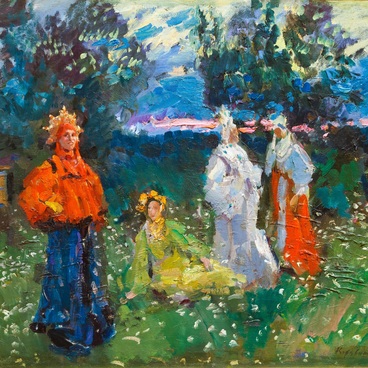The landscape At dawn. The mill held in the Khanty-Mansiysk State Museum of Fine Arts was painted by landscape artist Evgenii Stolitsa in 1906. Stolitsa was a pupil of landscape master Arkhip Kuindzhi.
Stolitsa often painted plain rural scenes: huts, dilapidated fences, mills and central Russia’s spacious vistas of nature. He maintained the traditions of 19th century Russian realist landscape painting, trying at the same time to impart it with decorativeness so liked by Kuindzhi. By type, At dawn. The mill resembles wall art: with its size, form and contents it was meant to fit the interiors and decorate them.
Against the background of a blue sky with violet clouds, the last rays of the setting sun paint scarlet the dark green treetops. The choice of colours makes everything in the canvas look mysterious and fantastic. In the foreground a bend of a small river leads the eye to the centre of the composition. Its dark waters merge with the lower part of the dense foliage of the trees. To the right Stolitsa painted two light wooden huts, one straw-covered and the other lit by the setting sun. To the left, concealed in the greenery, are the wheel of the water mill and a high wooden bridge over the river.
The contemporaries called Stolitsa the most Russian of painters – he preferred to use in his works, including The dusk, the subdued, cold palette and simple rural motives which added poetry and contemplation to his art. Stolitsa preferred a free, impressionist-like manner and skilfully conveyed the fine medium of light and air, atmospheric movements and the unaffected, immediate perception of nature.
Evgenii Stolitsa studied art first at Odessa’s technical school with Gennady Ladyzhensky, then moved to St Petersburg. In 1888 he started his classes at the Imperial Academy of Art with painter Mikhail Klodt and won two small medals and one big silver medal during his studies. In 1893, Stolitsa was given a grade and became a 2nd degree artist. In 1898, together with other pupils of Kuindzhi, he travelled to Germany, France and Austria. During the Russo-Japanese war in 1904 he painted battle scenes in Port Arthur during the time of Admiral Makarov there. He participated later in international exhibitions, and in 1908 became one of the co-founders of the Arkhip Kuindzhi Society of Artists. After 1924 he lived and worked in Moscow.
Stolitsa often painted plain rural scenes: huts, dilapidated fences, mills and central Russia’s spacious vistas of nature. He maintained the traditions of 19th century Russian realist landscape painting, trying at the same time to impart it with decorativeness so liked by Kuindzhi. By type, At dawn. The mill resembles wall art: with its size, form and contents it was meant to fit the interiors and decorate them.
Against the background of a blue sky with violet clouds, the last rays of the setting sun paint scarlet the dark green treetops. The choice of colours makes everything in the canvas look mysterious and fantastic. In the foreground a bend of a small river leads the eye to the centre of the composition. Its dark waters merge with the lower part of the dense foliage of the trees. To the right Stolitsa painted two light wooden huts, one straw-covered and the other lit by the setting sun. To the left, concealed in the greenery, are the wheel of the water mill and a high wooden bridge over the river.
The contemporaries called Stolitsa the most Russian of painters – he preferred to use in his works, including The dusk, the subdued, cold palette and simple rural motives which added poetry and contemplation to his art. Stolitsa preferred a free, impressionist-like manner and skilfully conveyed the fine medium of light and air, atmospheric movements and the unaffected, immediate perception of nature.
Evgenii Stolitsa studied art first at Odessa’s technical school with Gennady Ladyzhensky, then moved to St Petersburg. In 1888 he started his classes at the Imperial Academy of Art with painter Mikhail Klodt and won two small medals and one big silver medal during his studies. In 1893, Stolitsa was given a grade and became a 2nd degree artist. In 1898, together with other pupils of Kuindzhi, he travelled to Germany, France and Austria. During the Russo-Japanese war in 1904 he painted battle scenes in Port Arthur during the time of Admiral Makarov there. He participated later in international exhibitions, and in 1908 became one of the co-founders of the Arkhip Kuindzhi Society of Artists. After 1924 he lived and worked in Moscow.




